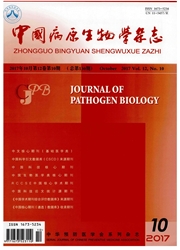

 中文摘要:
中文摘要:
目的研究海分枝杆菌感染PC-12神经元细胞的感染潜能及其诱导促炎性细胞因子表达的免疫特性。方法用海分枝杆菌感染神经营养因子(nerve growth factor,NGF)诱导分化的PC-12神经元,采用激光共聚焦显微镜观察细菌在PC-12神经元细胞内的定位分布,并计数细菌的菌落形成单位(CFU)以观察其在PC-12神经元细胞内的增殖情况;采用实时荧光定量PCR(qRT-PCR)、酶联免疫吸附试验(ELISA)及免疫印迹法(Western blot)检测肿瘤坏死因子(tumor necrosis factor,TNF)-α、白介素(Interleukin)-1β、诱导型一氧化氮合酶(inducible nitric oxide synthase,iNOS)和环氧合酶(cyclooxygenase-2,COX-2)mRNA及蛋白的表达情况。结果海分枝杆菌感染PC-12细胞后,激光共聚焦显微镜观察细菌侵入PC-12神经元胞浆内并进行增殖。当细菌以MOI=20感染神经元细胞时,感染后24h与感染后6h相比,细菌在细胞内增殖了约25倍。同时海分枝杆菌感染后6h即可诱导促炎性分子TNF-α、IL-1β、iNOS和COX-2的mRNA表达明显增加,感染24h后TNF-α、IL-1β、iNOS和COX-2的蛋白表达也明显增加。结论 PC-12能够作为海分枝杆菌感染的宿主细胞,并引起促炎相关因子的分泌,从而促进炎症反应。
 英文摘要:
英文摘要:
Objective To explore the potential for Mycobacterium marinumto infect PC-12 neurons and the immune response to that infection. Methods Neuronal differentiation of PC12 cells was induced with nerve growth factor(NGF)and the cells were then infected with M.marinum.The localization of M.marinum-GFP in relation to a differentiation marker,F-actin,was analyzed using confocal microscopy.Bacterial replication in PC-12 was assessed in colony-forming units(CFUs).Expression of TNF-α,IL-1β,iNOS,and COX-2mRNA and protein was detected using qRT-PCR,an enzyme-linked immunosorbent assay(ELISA),and Western blotting. Results M.marinuminvaded PC-12 cells and replicated in the cytoplasm.Bacterial proliferation was enhanced about 25-fold in PC-12 cells infected with M.marinumat an MOI of 20 for 24h,in comparison to M.marinumat an MOI of 20 for 6h.The expression of TNF-α,IL-1β,iNOS,and COX-2mRNA and protein was significantly upregulated in PC-12 cells 6hand 24 hafter infection with M.marinum,indicating a functional immune response. Conclusion Results revealed that PC-12 neurons can act as a host for infection with M.marinumand that PC-12 cells have the capacity to induce an inflammatory response when challenged with M.marinum.
 同期刊论文项目
同期刊论文项目
 同项目期刊论文
同项目期刊论文
 期刊信息
期刊信息
